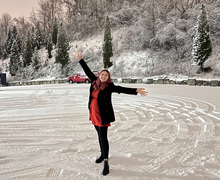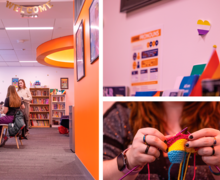Pooled saliva testing allows SU to overcome national rapid test shortage
Emily Steinberger | Photo Editor
About 67% of clinical labs worldwide are having issues obtaining both reagents and COVID-19 testing kits.
The Daily Orange is a nonprofit newsroom that receives no funding from Syracuse University. Consider donating today to support our mission.
Frank Middleton recognized in early March that the country needed to expand coronavirus testing immensely and quickly.
Middleton, the director of the Molecular Analysis Core at SUNY Upstate Medical University, has focused much of his research on identifying RNA using saliva samples. When the pandemic began, Middleton realized he could use a similar process to conduct widespread, saliva-based testing for the coronavirus.
“As soon as we reached the development of (the saliva-based) test, it became apparent to me that, in order to reach the most number of people possible, we should be developing (widespread testing) in parallel with the individual tests,” Middleton said.
Months later, the pooled saliva testing model Middleton helped design has become the backbone of Syracuse University’s coronavirus testing strategy. The tests, which pool 12 saliva samples together at a time, have allowed the university to test the entire campus population during a national shortage of commercially available rapid coronavirus tests, said Vice Chancellor Mike Haynie, who has spearheaded SU’s fall reopening plans.
SU partnered with Middleton and Upstate in June to implement pooled saliva testing on campus. Unlike individual coronavirus tests, which have been in short supply, the saliva testing kits were readily available because they aren’t typically used to detect COVID-19, Haynie said.
About 67% of clinical labs in the United States are having difficulties obtaining coronavirus testing kits, according to a study the American Association for Clinical Chemistry conducted.
“We were looking at a way to use public health surveillance to test a large population — mostly asymptomatic, healthy people — without disrupting the supply chain for diagnostic tests that are needed in health care facilities across the country,” said Brittany Kmush, an assistant professor of public health at SU who runs a lab that pools the university’s saliva samples.
Once SU collects individual samples from test subjects — students, in most cases — Kmush’s lab pools them together and sends them to Middleton’s lab at Upstate. There, the samples undergo testing for traces of COVID-19.

Katie Marcy| Digital Design Director
When a positive sample appears in one of the pools, the individuals in that pool receive an individual rapid diagnostic test. Limiting pool sizes to 12 students helps lower the number of individual tests needed when a pool tests positive, Kmush said.
“If your pool is really large, you’re doing a lot of individual tests if that pool tests positive,” Middleton said. “But if you’re doing an intermediate number based on the positivity rate of that campus, then you’re using the optimal amount of tests.”
SU has used the pooled testing system since students arrived on campus in August, in both regular surveillance testing and mass tests of the entire student body. The university has more recently shifted its strategy to “freedom from disease” sampling, which will entail ongoing, randomized testing of students.
The university will conduct another test of the entire student body in late October and again before the end of in-person classes on Nov. 24.
SU reserves its individual diagnostic tests for students whose pooled saliva sample tests positive, as well as students who show COVID-19 symptoms or have been exposed to the virus, Haynie said.
“We only use rapid diagnostic tests to confirm known or suspected COVID-positive cases – therefore preserving those resources that are in short supply,” he said.
One of the first instances in which Middleton and his team used the pooled saliva testing model was when SU football players returned for summer practices, Middleton said.
While the athletes had to receive coronavirus tests prior to arriving on campus, the pooled saliva tests were able to detect positive cases in players who had already been cleared for practice, Middleton said.
The pooled saliva tests not only allow for widespread testing without straining limited resources, but they also save time and money, Middleton said. Upstate’s lab estimated that the pooled saliva system has saved universities about $9 million, he said.
The lab has conducted nearly 121,000 pooled saliva tests across 40 campuses in New York state, including about 40,000 at SU since August. SU has been taking “exemplary” precautions to limit the spread of the virus on its campus, Middleton said.
The university identified a cluster of coronavirus cases among students Tuesday that are related to at least one off-campus party that took place at an apartment complex on Walnut Avenue late last week. The cluster has resulted in as many as 45 new coronavirus cases among SU students, Haynie said in an SU News release.
The university has since isolated and quarantined students who could have a connection to the cluster and is working with the Onondaga County Health Department to trace the outbreak.
“I haven’t seen another campus equal (SU) among all the other campuses we’ve done testing for,” Middleton said. “Syracuse University is truly committed in a very, very dramatic way. And that’s been the big game-changer.”
Published on October 7, 2020 at 11:51 pm
Contact Maggie: mehicks@syr.edu | @maggie_hickss






